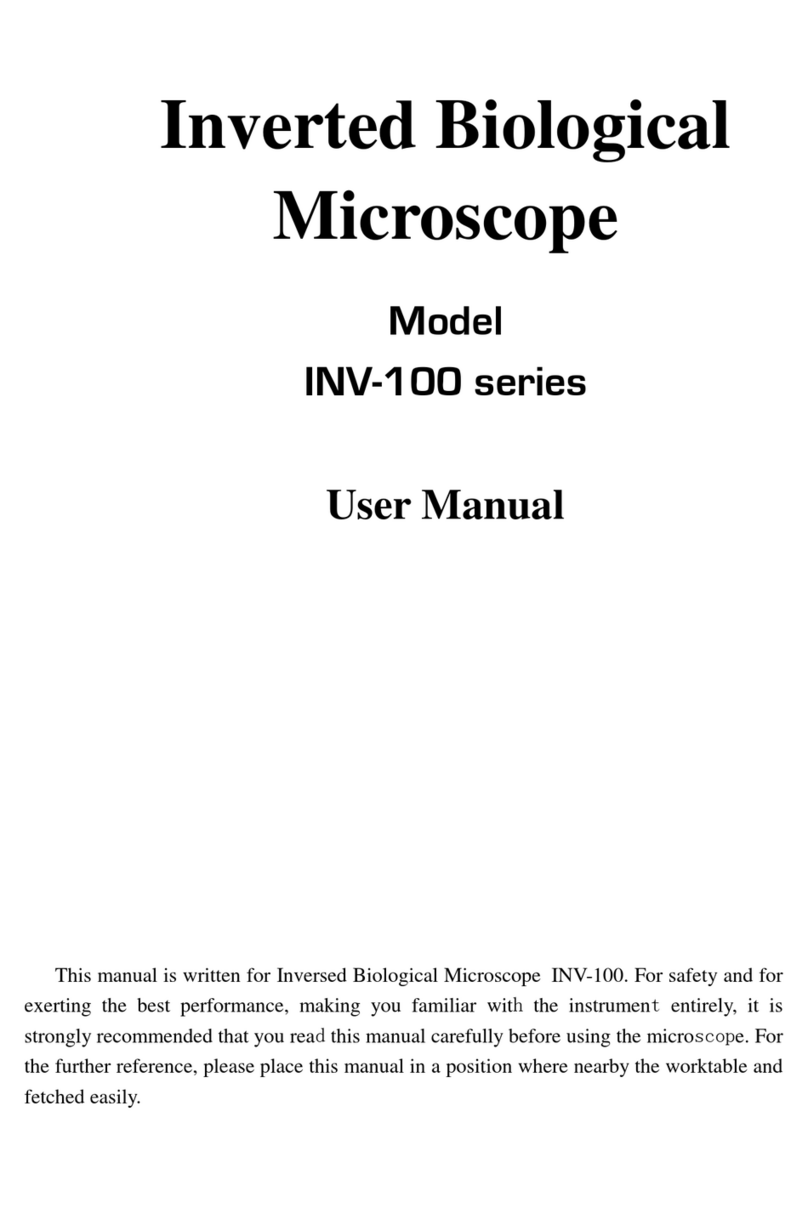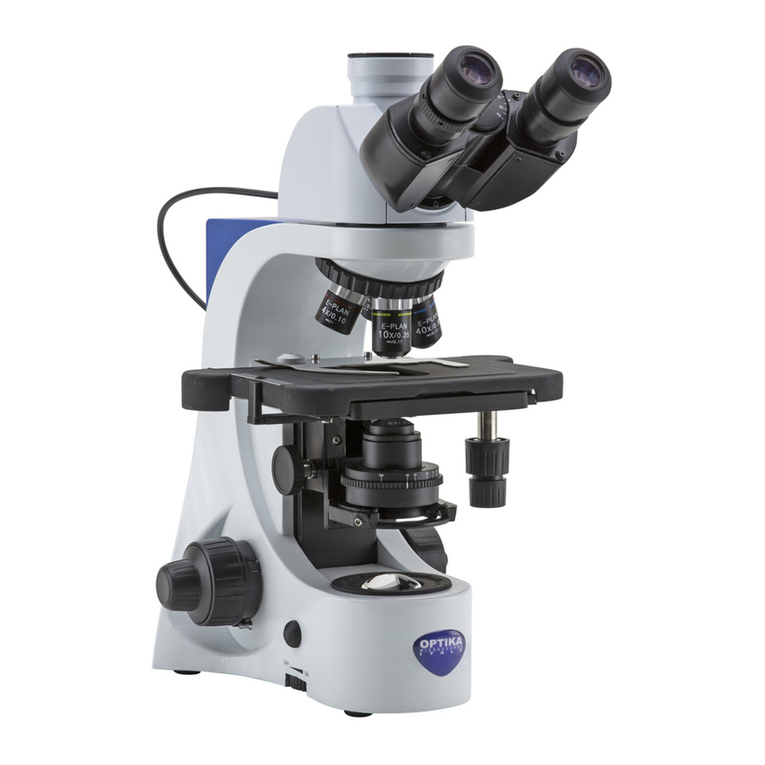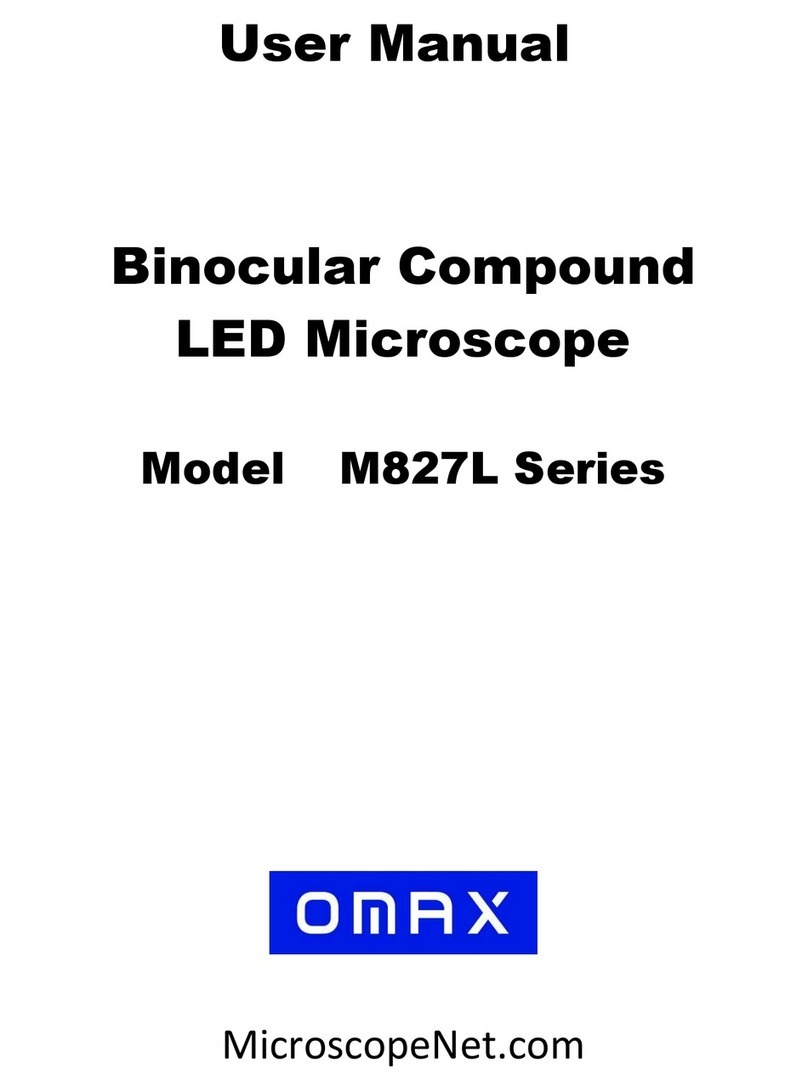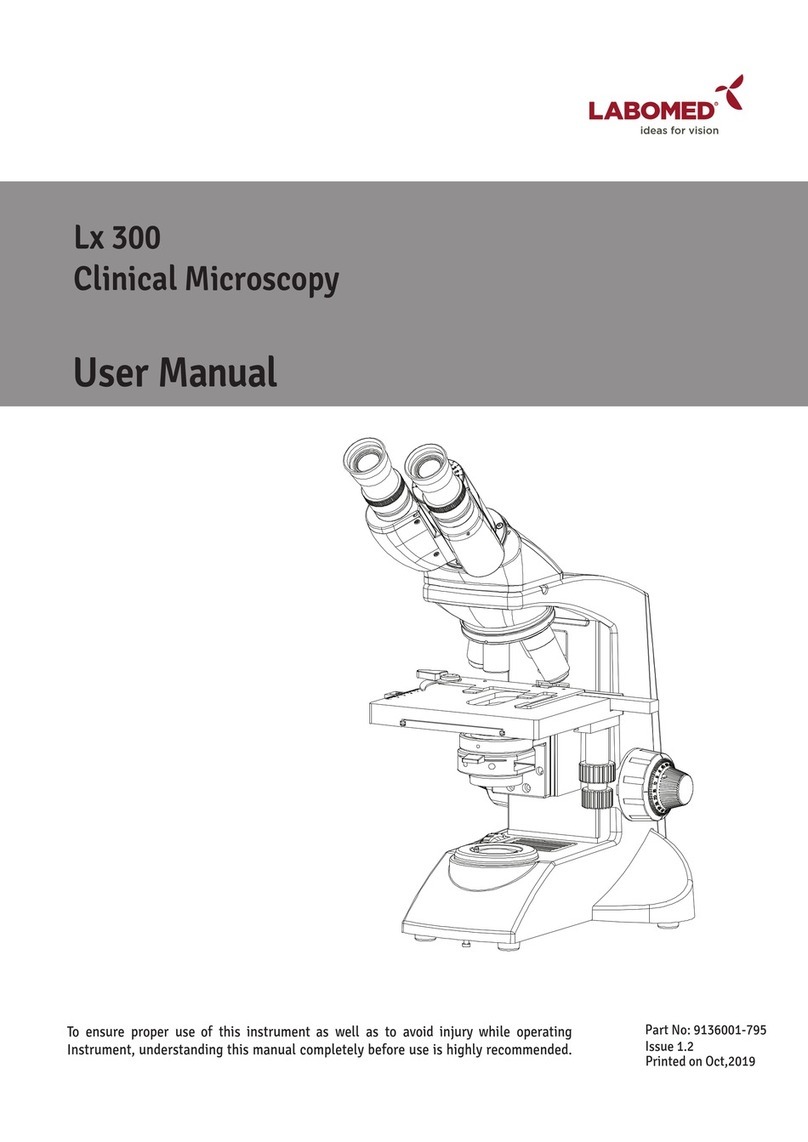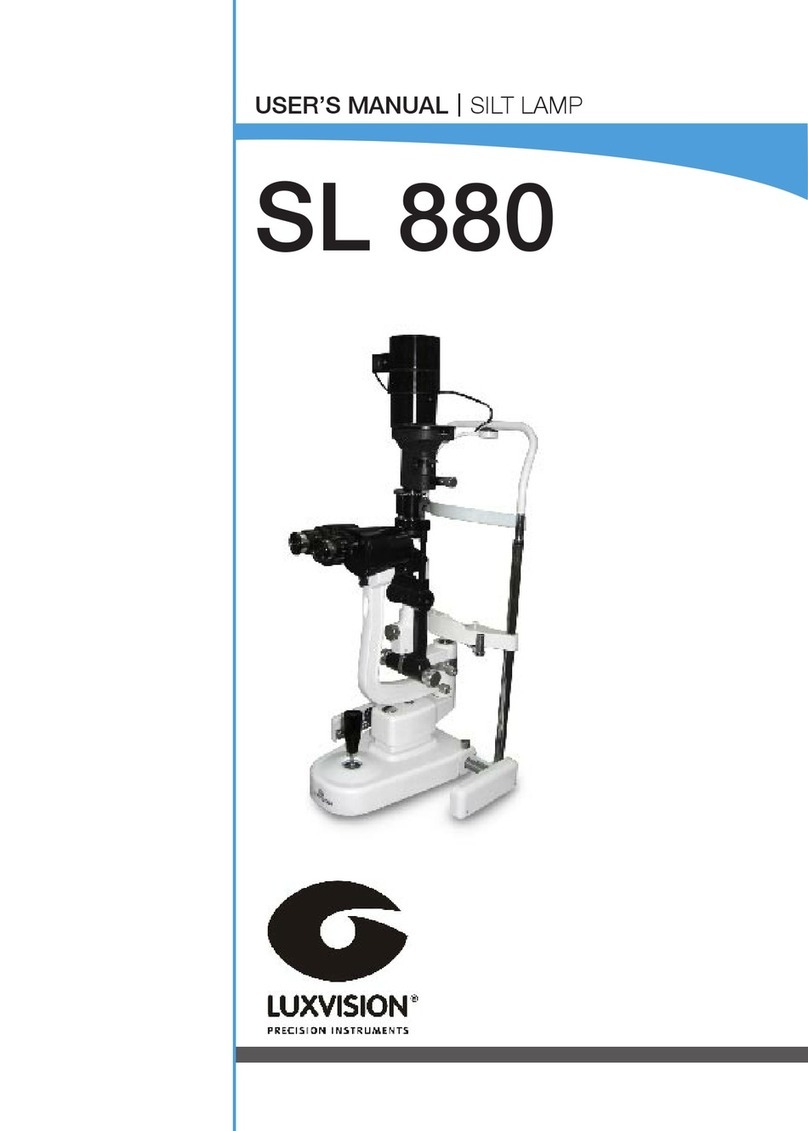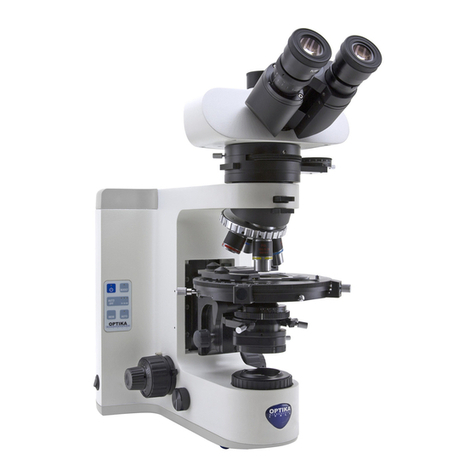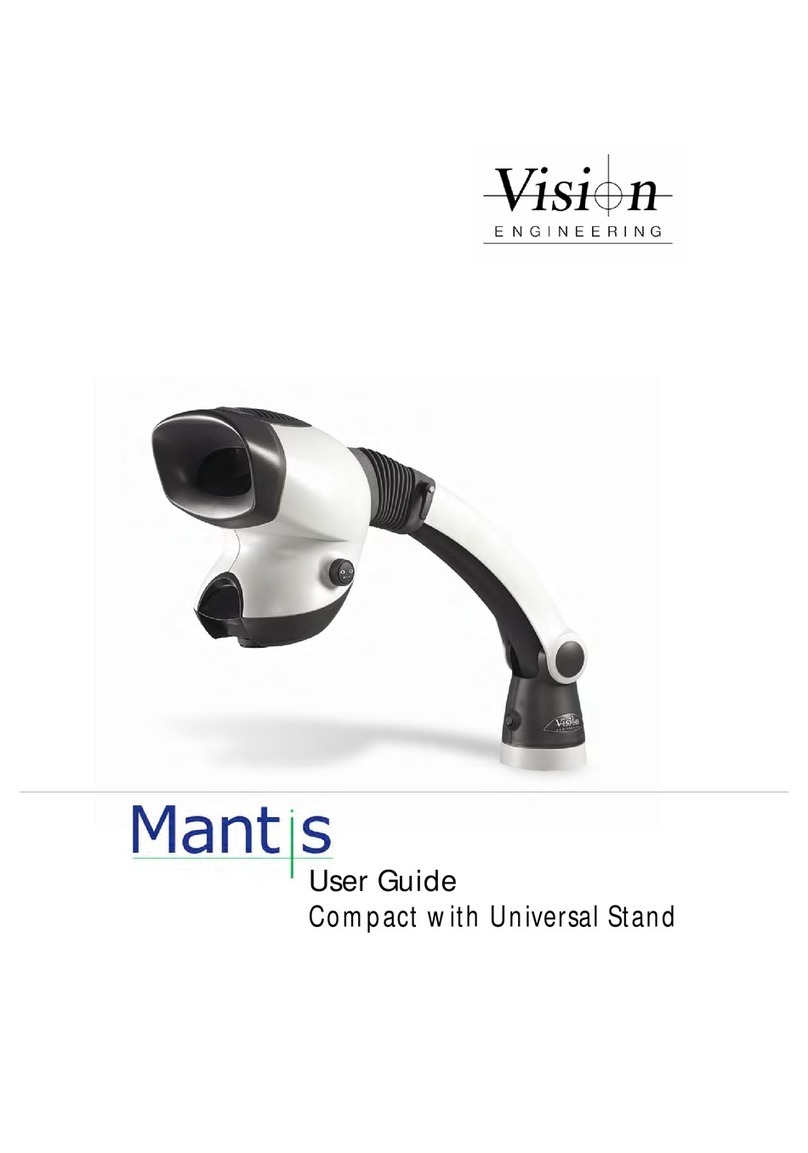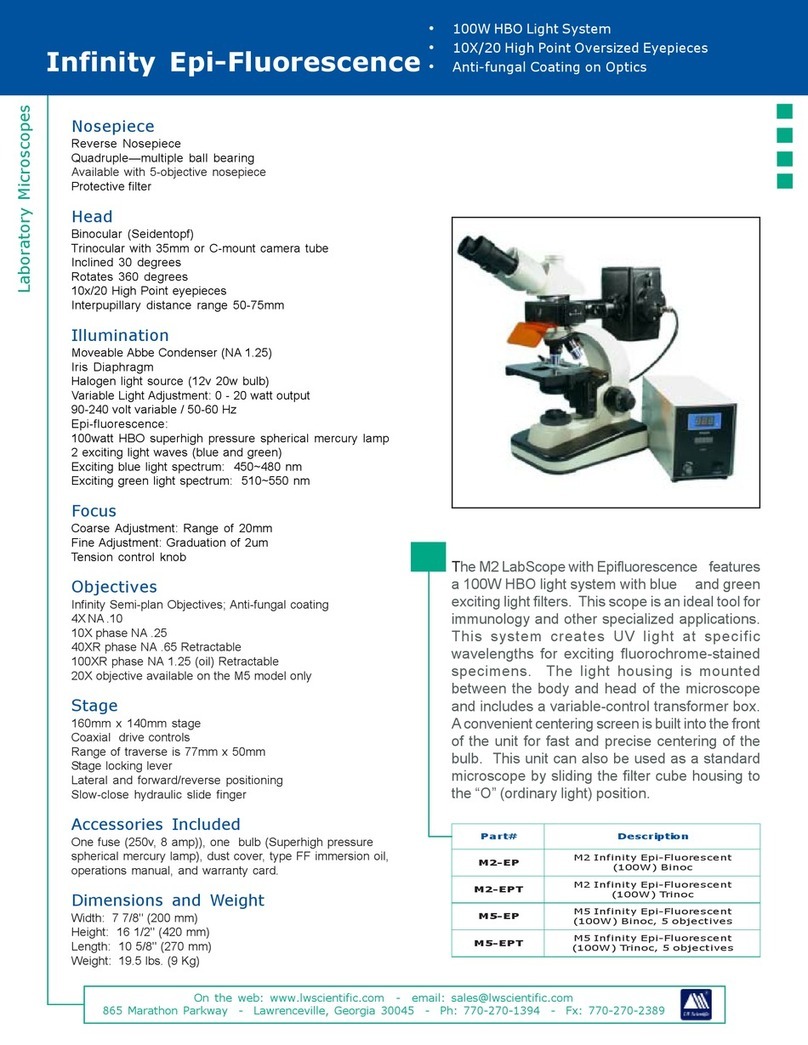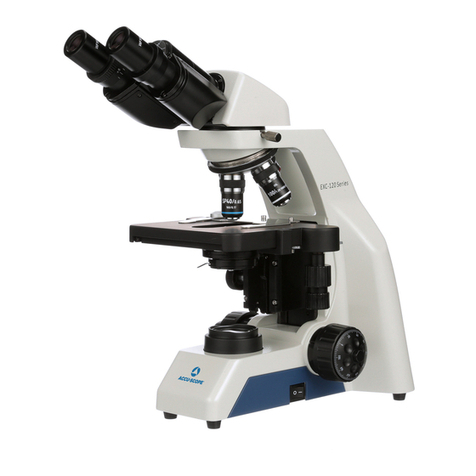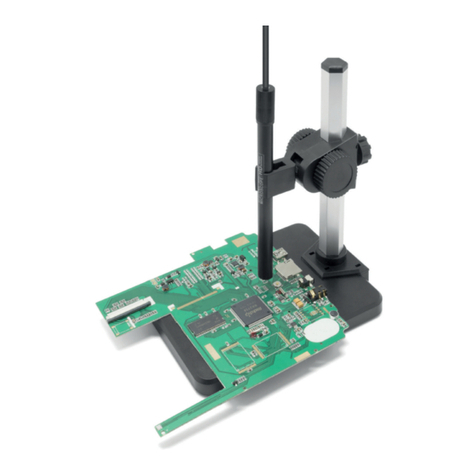BEL Engineering INV100-FL User manual

Inverted Fluorescence
Microscope
INV100-FL
USER MANNUAL
This manual is written for Inverted Microscope INV100-FL. For safety and for exerting
the best performance, making you familiar withthe instrumententirely, it is strongly
recommended that you readthis manual carefully before using the microscope.

2/27
Contents INV100-FL
Contents…………………………………………………………………… 1
User Notices………………………………………………………………… 2
1.Components Name………………………………………………………… 4
2.Assembly…………………………………………………………………… 5
2.1 Installment figure……………………………………………………… 5
2.2 Installment steps……………………………………………………… 6
3. Adjustment and opertation…………………………………………… 11
3.1 Lamp adjustment for fluorescence observation ………………… 11
3.2 Lamp adjustment for biological observation……………………… 17
4. Microscope photography and video……………………………… 19
4.1Microscope Photography……………………………………………… 19
4.2 Microscope Video…………………………………………………… 20
5.Technical Specifications………………………………………………… 21
5.1 Outfit………………………………………………………………… 21
5.2 Objective Specification…………………………………………… 23
6.Troubleshooting………………………………………………………… 24

3/27
Notices INV100-FL
Safety Note
1. The epi-fluorescent attachment is a precise instrument. Open the box carefully, and avoid
dropping the accessories to ground and causing damage to them.
2. Do keep the instrument out of direct sunlight, high temperature or humidity, dusty and
virations.
3. Make certain that the burner is installed correctly and all cords are connected firmly.
4. Do not open the lamp housing while it is turned on or for at least 10 minutes after it has
been turned off. Lamp housing parts are extremely hot and cause burns if touched.
5. Always be sure to ground (earth) the equipment.
6. Verify that the voltage and the frequency of the AC mains outlet match the setting of the
voltage switch and the frequency switch on the rear of the power supply unit.
7. Always use the power cord provided and make sure that the main switch is moved to
“O”(OFF) before connecting the power cord plug to the wall outlet.
8. To prevent any hazard, always turn the main switch on the power supply unit to “O”
(OFF), unplug the power cord plug from the mains outlet before replacing the burner or
the fuse, and wait for at least 10 minutes before replacing the burner. (Be sure to use a
GCQ-100 mercury burner.)
9. To prevent obstruction of the air flow, it is important to leave enough space around and
above the lamp housing.
Safety Symbol
Symbol Meaning
The surface is very hot, not touch by your hands
Before using ,please read the instruction carefully, improper operation will result in
bodily injure or instruction malfunction.
The main switch on
The main switch off

4/27
INV100-FL
Maintenance and Storage
1. Clean all glass components by wiping gently with gauze. To remove fingerprints or oil
smudges, wipe with gauze slightly moistened with a mixture of ether (70%) and
alcohol (30%).
Since solvents such as ether and alcohol are highly flammable, they must be
handled carefully. Be sure to keep these chemicals away from open flames or potential
sources of electrical sparks-for example, electrical equipment that is being switched on
or off. Also remember to always use these chemicals only in a well-ventilated room.
2. Do not attempt to use organic solvents to clean the non-optical component of the
equipment. To clean these, use a lint-free, soft cloth lightly moistened with a diluted
neutral detergent.
3. Do not disassemble any part of the power supply unit as malfunction or damage may
occur.
4. In order not to impair the safety of the equipment, replace the burner when the
counter of power supply indicates “100.00” hours. To prevent any hazard, always turn
the main switch on the power supply unit to “O” (OFF), unplug the power cord plug
from the mains outlet, and wait for at least 10 minutes before replacing the burner.
High-pressure gas is sealed within the mercury burner. Thus, if it is continued to be
used after its service life expectancy, the glass tube may deform and may sometimes
rupture.

5/27
1.Components’ name INV100-FL
Trinoculartubehead Phasecontrastslider Lamp
reflected fluorescence units
Condenser
Illumination bracket
eyepiece
Stage inserted plate
Stage
Body
nosepiece
Objectives
。4×
。10×
。20×
。40×
Fluorescence power supply
Protection barrie
r
B excitation G excitation
l
INV100-FL inverted fluorescence microscope

6/27
2Installation NIB-100
2.1 Installing diagram
The following figure shows the installation sequence of the components. The number in the
figure shows the installation steps.
Before installing, be sure every components is clean, do not score any parts or glass surface.
Keep well with the supplied hexagon wrench. When changing the components, you will need it again
。
①
②
④
③
⑤
⑥
⑦
⑧
Condenser
illumination unit
Phase contrast slide
r
Lamp house
E
y
e
p
iece
Trinocular tube
Ob
j
ectives
Glass stage
Power supply unit
Mechanical ruler
Body Stand
Stage lengthen splint
⑨
Power supply
⑩
⑾
⑿
Lever
Protection barrier

7/27
2.2 Installment steps INV100-FL
2.2.1 Installing trinocular
head(fig 1)
Loosen the setscrew ②and insert the
trinocular Viewing Head ①into the body
correctly , screw down with bolt③.
2.2.2 Installing eyepiece(fig 2)
Insert the eyepiece④into tube until they
are against.
2.2.3 Installing condenser
set(fig3)
Install the condenser into the right
direction(fig3)。
图1
Fig 2
②
①
③
④
Fig 3

8/27
INV100-FL
Fi
g
4
A
2.2.4 Installing lamp house(fig4、fig5)
Insert the plug A into hole A of power cord. then
insert theplug B into the B hole of the condenser
till there are against. (Fig 6)。
2.2.5 Installing phase contrast
plate(fig6、fig7)
1. Keep the slider①face ( the surface which had
character) up towards,。Every light ring or opening
has its own located position, so you need to move
them until you heard the “clicked” to ensure the ring
or the opening reache the center of the light
path(show as fig 7)。
2. Turn the aperture diaphragm lever ① to
adjust aperture。Turn the diaphragm to a big
aperture when do phase contrast observation。
● The light ring was centered beforehand, so
it needn’t to adjust in the use process.
If the ring is not in the center, you could
adjust by the centering bolt.
● The 10X/20X light ring is worked with the
10X,20X phase contrast objective, while
the opening is used for bright field .
A
B
A
B
Fig 5
Fig 6
Notices
Requirement :
1. temprature:0℃~40℃,max humidity:85%。
2. high temperature and moisture will damage
instrument and affect performance。
3. keep the instrument from the dust
environment ,and take the dust cover when no
using 。
4. lay the instrument without vibration place。
Fig 7
①
Replace lamp
1. Turn the swith to off position when using or
need replacement.pull out the lamp house and
then the lamp after it is cool down competely。
2. Insert the new lamp softly to prevent damage。
3. Do not touch the lamp by hands to prevent
reducing lamp expectancy or explode。Clean
the fingerprint by wiping slightly moistened
with ether

9/27
INV100-FL
Fig 8
③
②
①
2.2.6 Installing the objective (fig8、fig9)
1. Turning the coarse fusing knob①like the figure
shows till the nosepiece get to its lowest position.
★For ensuring the safety of the instruction
on transportation, the nosepiece is located in the
lowest position and the tension adjustment
collar②is adjusted in a appropriate tight
tension while leaving the factory.
2. Screw the lowest magnification objective on to the
turret from the nearside, then turn the turret
clockwise, mount other objectives according the
magnification sequence of low to high.
◎Mount objective like this way will make the change
of magnification to be very easy in using.
◎ It also can install the objective through the
stage opening.
★Clean the objective regularly, the objective used in
the inversed microscope is very sensitivity about
dust.
★ Do cover all the unused holes with turret dust
caps③, to prevent the dust and contamination
entering inside.
★ When operating, use the low magnification objective
(4X or 10X)to search and focus the specimen at
first, then replace the higher magnifications if
necessary.
★ When replace the objective, slowly turning the
nosepiece until you hear “clicked”, that means the
objective enter into the right position—center of
the light path.
2.2.7 Mounting the Mercury Burner (fig10、
fig 11)
1.Loosen the burner socket clamping screw , and
remove the burner socket.(fig.1)
2.After removing the foam backstop②, securely insert
the + pole (the wide head) of the specified mercury
burner③to the lower teminal first and then the –
pole(the thin head) to the upper terminal, then
tighten the two socket clamping screws④.
3.Close the burner socket with burner into the original
position and tighten the socket clamping screw.
Fig 10
Fig 9
①

10/27
INV100-FL
Fig 13
●Be sure to use a GCQ-100 mercury burner.
●Be sure to mount positive pole(the wide head) before
the other , or the damage to the burner may occur.
●Never subject the burner to excessive force when
mounting the Mercury Burner.
●Be careful and avoid leaving fingerprints or dirt on the
mercury
b
urner. Attached stain may cause distortion in
glass which could result in a ruptured burner. If
stained, wipe it a way gently with clean gauze.
★
To prevent any hazard, always turn the main switch on
the power supply unit to “O” (OFF), unplug the power
cord plug from the mains outlet, and wait for at least
10 minutes before replacing the burner.
2.2.8 Assembly of the Fluorescent
Attachment , Cable and Cord Connections
(fig 12、13)
1. Mount the lamp housing into the other end of the
attachment and fix it with two screws④。
2.Plug the connector ⑤from the burner socket securely
into the connector on the power supply unit and make
sure the cord is correctly connected. (Make sure that
the main switch④of the power supply is set to “O”
(OFF)before connecting cables)
3. Connect the power cord connector ⑥into connector
on the power supply unit and make sure the cord is
correctly connected.
●Verify that the voltage and the frequency of the AC
mains outlet match the setting of the voltage switch
and the frequency switch on the rear of the power
supply units and improper setting may degrade burner
performance , or in the worst case(although very
rare ), cause the burner to explode.
●It is better to use the power cord provided by NOVEL
and the same type power cord should be used if you lose
or damage the old one
2.2.9 fuse Replacement (fig 12、13)
1 Set the main switch to “O”(OFF)and unplug
the power cord before replacing fuses.
2 Using a flat-blade screwdriver, remove each of the
fuses holders⑦by tuning it counter- clockwise。
and pulling out.
3 Replace both fuses with new ones.
●Always use the designated fuses (8A). And make sure
the voltage of the fuse match the voltage of the AC
mains outlet.
②③
Fig 12
Fig 11
④frequency
⑥
⑤
voltage

11/27
INV100-FL
Fig 14
①
Fig 15
Fig 16
2.2.10
Installin
g
the sta
g
e len
g
then splint and
the mechanical ruler
(fig 14、15)
◎ Stage lengthen splint can be installed in either
side of the stage to enlarge the work surface.
But you can’t install the mechanical ruler
together.
◎ Generally , the mechanical ruler will be installed
in the right side for comfortable adjustment.
1. Installing the stage lengthen splint
First, Screw the fixed bolt①on to the splint ,
then mount it on to the stage from right or left
below, screwing down it until it stay hard.
2. Installing the mechanical ruler
Please install the ruler like the way of the stage
splint.
。
2.2.11 Installing protection barrier,
glass plate, lever (fig 16)
1. Install the protection barrier on the attachment by
tightening the screw.②。
2. Placing the glass plate to the right
position。
3.Screw the lever to the inversed components
under the nosepiece。
②③

12/27
3. Adjustment and operation INV100-FL
3.1.1 Connecting power
Set the main switch of the power supply unit to“I”(ON). It will stabilize in 5 to 10 minutes
after ignition.
●Some mercury burners may not ignite the first time the power is turned on due to variance
in production, and the safety mechanism in the starter in such a case. If this occurs, set the
main switch to “1”(ON), then press the starter reset switch on the front panel of the power
supply and between 1 to 4 seconds are required for igniting the burner. Repeat as necessary.
●To avoid shortening the burner life, do not turn the burner off within 15 minutes after
ignition.
●The burner cannot be re-ignited for about 10mimutes, that is, until the mercury
vapor inside it has cooled down and condenser to liquid.
●Ensure that the hour counter is reset to “000.00” after replacement of the burner.
And you can insert a thin object such as a mechanical pencil tip into the reset
hole on the front panel of the power supply unit to press the internal switch
3.1.2 Function of button (fig 1)
①Hour counter
②Ammeter。
③Excitation button
④Start reset button
⑤Voltage switch
3.1.3 Adjusting the diopter (fig 2)
1. Look into the right ocular by your right eye,
then revolving the coarse focus kno
b
to focus
on the specimen.
2. Then use your left eye to look into the left
ocular. If the image is not sharp, just use the
diopter adjustment ring①to adjust please.
★There are ±5 diopter in the adjustment
ring. The number which the reticle on the
eyepiece holder pointed is your eye’s diopter
graduation.
Fig 1
1
2
3
①②
④⑤
③
on

13/27
INV100-FL
3.1.4 Adjusting the interpupillar distance
(fig3、4)
When observing with two eyes, hold on the left and
right prism holder, turn around the axis, adjusting the
interpupillar distance until the left and right fields of view
coincide completely.
★The reticle on the interpupillar distance indicator③,
pointed by the spot “.” ②on the eyepiece holder, shows
the scale of the interpupillar distance.(fig.21)
The range of the interpupillar distance:48~
75mm。
3.1.5 Switching the light path (fig 4)
◎ Pulling out the light path selector lever① by
your thumb, select the light path you needed.
◎ when in the binocular observation, pushing in
the lever until you heard a “clicked” .while
in video or photography, pulling out the lever
until it reached the “clicked” position.
Light path
selector lever
Brightness
proportion
application
Pushing in the
lever until it
reached the
limit position
100% used for
binocular
observation
Binocular
observation
Pulling out
the lever
until it
reached the
limit
position
20% used for
binocular
observation,
and 80% used for
video or
photography
Binocular
observation,
television, and
micrography or
video can be
operated
simultaneous
3.1.6
Mounting Auxiliary Stage
(fig 5)
1. When using mechanical ruler .located the
specimen by moving the X,Y knob(120mm X 78mm)
2. use the stamdard specimencover(1.2mm)for best
observation。
● Carely replacing objectives.orelse the
objective will touch the inserted glass plate whe
observating the specimen by short-working
distance objective。
Fi
g
3
Fi
g
4
④
Fig 5
①②

14/27
INV100-FL
3.1.7 Centering the mercury burner
(Fig.4-6)
◎Before proceeding to center the burner, wait for the arc
image to stabilize to protect against glare during arc
image centering, it should be viewed across the
excitation light protective shield.
1.Switch the light shutter ①to“●” position to shut
off the light path.
2.Revolve the filter block turret to engage the green or
b
lue excitation filter block into the light path. If U/V
excitation filter block used, be sure to use the
protective shield.
3.Revolve the nosepiece to engage 10×objective into
th e l ight pa th . Place the centering plate on stage, through
transmission observation;,adjust the stage until the cross is
in the centre of the field of view.
4.Remove the objective from the revolving nosepiece
position and engage this position in the light path.
5.Pull out the field iris diaphragm lever②to close the
iris diaphragm and push in the aperture iris
diaphragm lever③to open the iris diaphragm to the
large limit.
6.Switch the light shutter①to “O” position to open the
light path.
7.Turn the collector adjusting knob④to project the arc
image on the centering plate and sharpen it.(A)
8.Revolve the burner adjusting knob⑤to move the arc
image and the mirror reflected arc image in the
symmetrical position。(B)
9.Adjust the mirror focusing knob⑥(Fig.6) to sharpen
the mirror reflected arc image. (C)
10.Turn the burner adjusting knob⑤to overlap the arc
image with the mirror reflected arc image.(D)
◎Turn the collector adjusting knob④to make the field
of view as bright as regular as possible..
◎Maintain this condition until the next time the burner
is replaced.
Fig 7
②①
Fig 8
⑤⑦
④⑥
Fig. 6
③

15/27
Note:
●When the hour counter indicates ”100.0”,set the main switch to “o”( OFF) for safety, wait for
more than 10 minutes, then replace the lamp burner after making sure that the lamp housing has
cooled down..
A mercury burner seals high-pressure gas inside. If the burner is used beyond its service life, stress
may accumulate inside the burner, and in the worst (but very rare) case, the burner could
explode.。
●After replacing with a new burner, reset the hour counter, be sure to press the reset switch until
“000.00” is displayed.

16/27
INV100-FL
Centering the mirror reflected image (Fig.6)
★ The mirror reflected image has been centered
b
efore leaving the factory. Do not adjust the
knob⑦please if not necessary. Only when the
b
urner has been centered precisely, can the
knob⑦be adjusted.
Note: once the knob is adjusted, the reflected
mirror cannot be reconverted to the status when
leaving the factory.
Knob control:(Fig.6):
1.The middle knob ⑥is the mirror reflected
image focusing knob which can sharpen the
reflected image.
2.The knobs at both sides⑦can adjust the
up/down or left/right position of the mirror
reflected image.。
3.1.8 CenteringtheFieldIrisDiaphragm (fig
9、10)
1. Engage the 10×o
b
jective in the light path, and
place the specimen on the stage and bring into
approximate focus.
2. Pull the field iris diaphragm lever②out
until the diaphragm comes into the smallest
state.
3. Use the hexangular wrench to adjust the
two field iris diaphragm centering screws
alternately to move the image of the
diaphragm to the center. (Fig.2 show the
adjustment of diaphragm)
4. Push in the field diaphragm lever to open
the diaphragm. As this makes slight
deviation noticeable, adjust the centering
precisely.
5. Enlarge the diaphragm until it just
circumscribes the field of view.
Fig 9
②
①③④
Adjusting the field iris diaphragm The field diaphragm
adjusts the diameter of the illuminating beam to obtain good
image contrast. Keeping the field diaphragm stopped down to
the smallest required area for each observation makes it
possible to prevent color fading of areas outside the
observation target region. According to the objective in use,
adjust the diaphragm image using the field diaphragm lever so
that the field of view is circumscribed by the field diaphragm
to exclude stray light.
Fig 10
c
b
a

17/27
INV100-FL
● To recognize the aperture diaphragm, you could remove the eyepiece if necessary.
( you also could insert in the center telescope )then looked into the viewing tube,
you might see a field of view like the figure shown. The proportion could be changed
by dialing the aperture adjustment lever according your need. (①is the image of
the aperture diaphragm , ② is the edge of the objective)
● Generally, when observing the chromatic specimen, you need to set the size of
the condenser aperture diaphragm at 70%~80% of the numerical aperture which marked
in the objective. but if observing the bacterium specimen which not colored, you
could turn the aperture diaphragm lever at the direction of“ ”(clockwise)
3.1.9 Using color filters(fig11)
◎ Selecting the appropriate color filters
according your need, it became more effective
to observe or photography the specimen.
Especially, we suggest using the LBD color
filter, which can compensate more neutral
colors.
◎ You could pile up a group of color filters to
the filter holder, if you ensure they are level
and the whole thickness is less than 11mm.
Color
filter meaning
IF550
Single contrast color filter (green)
(used for the phase contrast
microscopy)
LBD
Color temperature transit color
filter(blue)
(used for bright field observation
and microphotography)
3.1.10 using the aperture diaphragm(fig 12)
◎
When in the bright field observation, the
aperture diaphragm control the numerical aperture
of the illumination system. Only when the numerical
aperture of the objective and the illumination
system being matching, you can obtain the higher
image resolution and contrast, and the increased
depth of field, too.
Fig 11
Fig 12
①
②
70-80%
30-20%

18/27
INV100-FL
knob
3.2 Reflected observing illumination
adjustment
3.2.1
Turn power,adjusting brightness(fig 13)
Connect the power, turn on the main switch①(shown
on the fig.16)which on the bottom side of the base to
“-”(on)
Turning the brightness adjustment knob
clockwise, the voltage raise, and the brightness
strengthen; whereas turning at the contra direction,
the voltage decline, and the brightness weaken.
◎ Using the lamp in a low voltage condition, will
prolong the service life2.
3.2.2 Ad
j
ustin
g
the Tension Ad
j
ustment
Collar (fig14)
The tension of the coarse focusing
knob
②
has already been adjusted properly
before leaving factory.
◎How to adjust the tension of the coarse focusing
knobTurning the tension adjustment collar .
while revolving at the direction of the arrow in
the figure, the tension of the coarse focusing
knob is increasing ;and if at the contra
direction ,the tension will decline.
3.2.3 The centering ring (fig 15、16)
★ Usually you needn’t the operation of
centering. If necessary, please accord to
the following steps:
1. Place the specimen on the stage and
focus it.
2. Take out the eyepiece, replace it with the
CT ( the centering telescope),and inserted
it into the viewing tube without diopter
adjustment.
3. Make sure the matched phase contrast
objective and light ring( in the phase
contrast slider) have been in the center of
the light path
Fig 13
②
①
Fig 14
③
②
①
Fig 15
2
1
③
Fig 16

19/27
4. Using the CT to look the light ring’s image① and the phase contrast ring’s
image②, if the light ring’s image is not sharp, please shifting the CT’s
ocular until you can see a clear image of the light ring②.
5. Adjusting the bolts of the two centering holes③ in the phase contrast slider
by the screwdriver ③until the light ring center and the phase contrast center
are coincided.
6. The 10X and the 20X phase contrast objective use the same light ring on the phase
contrast slider. So you need to check the coincidence of the light ring center
and the phase contrast center when changing the objective. If having departure,
you ought to center again.
★ If the light ring is centering incorrectly, you will fail to obtain the best
viewing effect of the microscopy.
★ After removing or replacing a thick specimen, the light ring and the phase
contrast ring are likely to deviate each other, which will result in a decline
of the image contrast. So if happened, please repeat the steps as above.
★ If the container or the cover flip which used to place the specimen is not flat,
it maybe need to repeat the centering steps for obtaining a more contrast effect.
Please center the light ring by the phase contrast objective, according to the
sequence of low to high magnification.

20/27
4.Microscope photography and video INV100-FL
Fig 1
1
4.1 Microscope video
4.1.1 selecting the light path(fig.1)
★ just used in the trinocular observation
1. Pulling out the light path selector lever, until
you heard the “clicked”.
★In the dark specimen observation, you can make
the focus by both eyes at first, then change the
light path.
4-1-2 Installing the video set(fig.2)
1. Loosen the locking bolt①on the trinocular
viewing tube, and take out the dust cap②.
2. Remove the dust cover on the both ends of the
video accessories③, and revolve the screw
head end into the CCD/CMOS port.
3. Install the accessories into the tri-through port,
and screw down the bolt①.
4-1-3 Focus(fig.2)
Doing a binocular observation at 20%
brightness, look the image on the video
or the computer which connected with the
microscope video system when the image
is sharp. If it is not in focus, please
turning the revolving video connected
tube④ until the image is sharp enough.
Fig 2
1
CCD
视频
2
3
4
Video
Table of contents
Other BEL Engineering Microscope manuals
Popular Microscope manuals by other brands
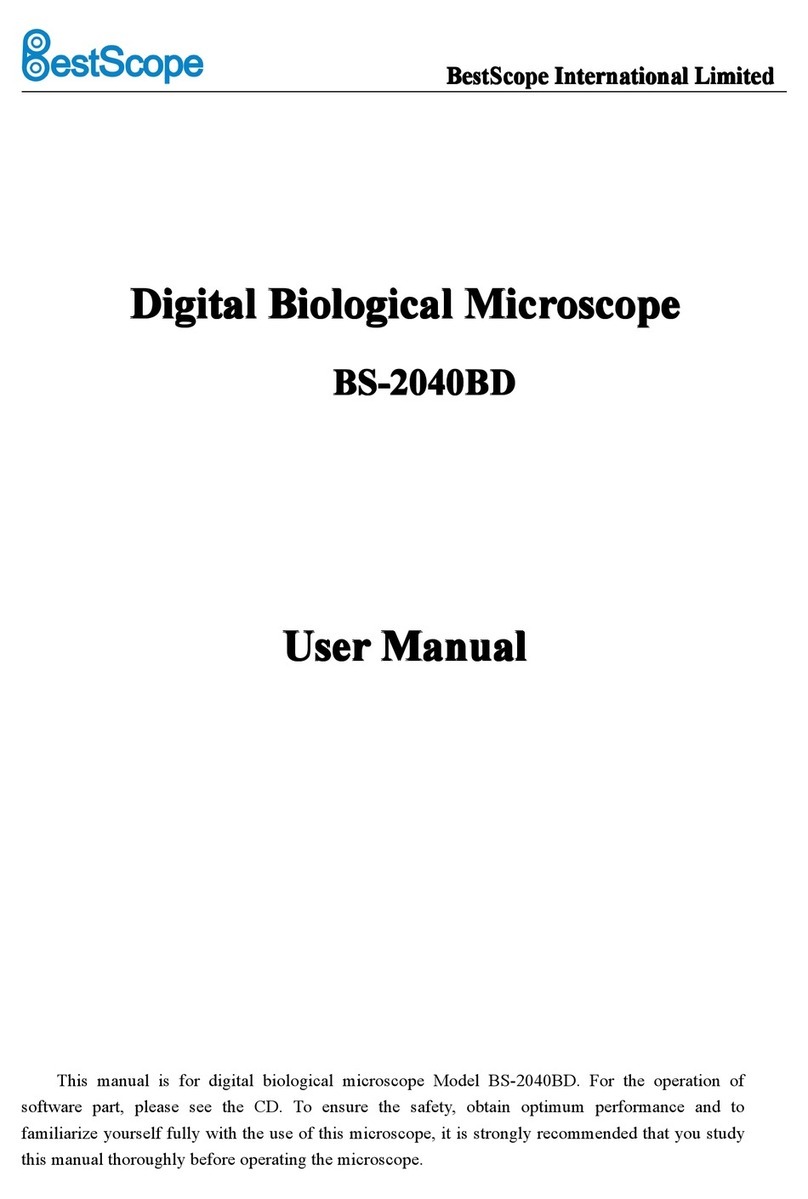
BestScope
BestScope BS-2040BD user manual

Olympus
Olympus IX71 Installation
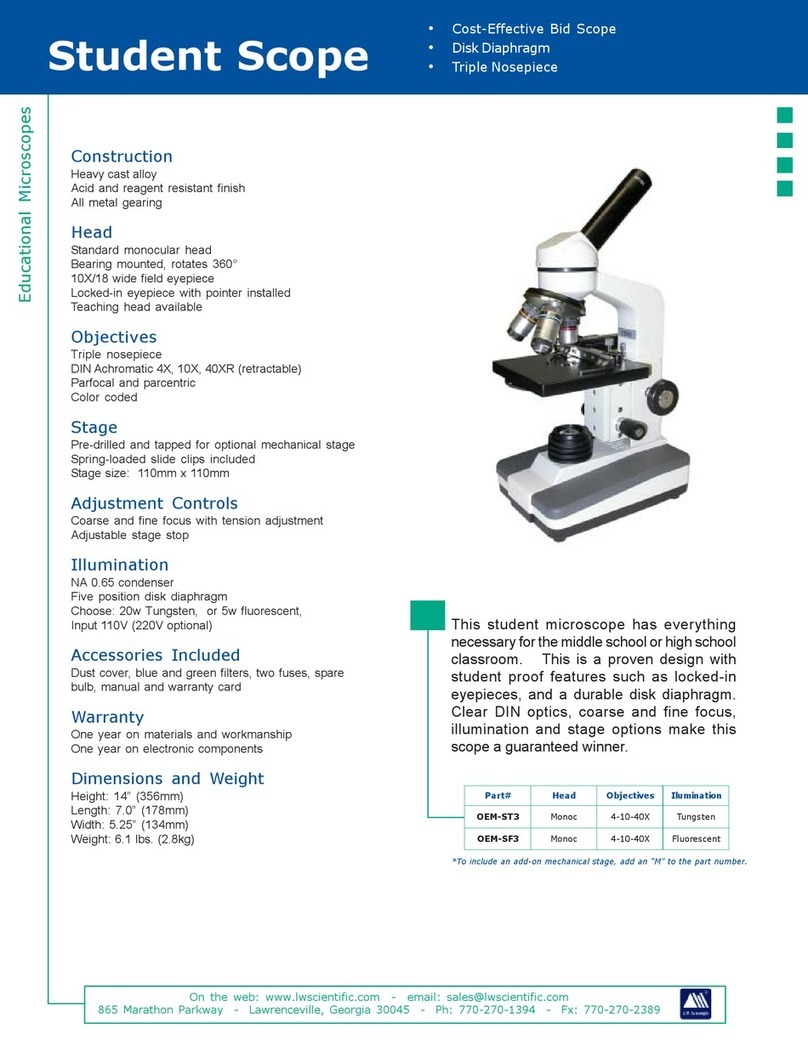
LW Scientific
LW Scientific Student Scope OEM-SF3 Specifications

3B SCIENTIFIC PHYSICS
3B SCIENTIFIC PHYSICS 400 1003274 instruction manual
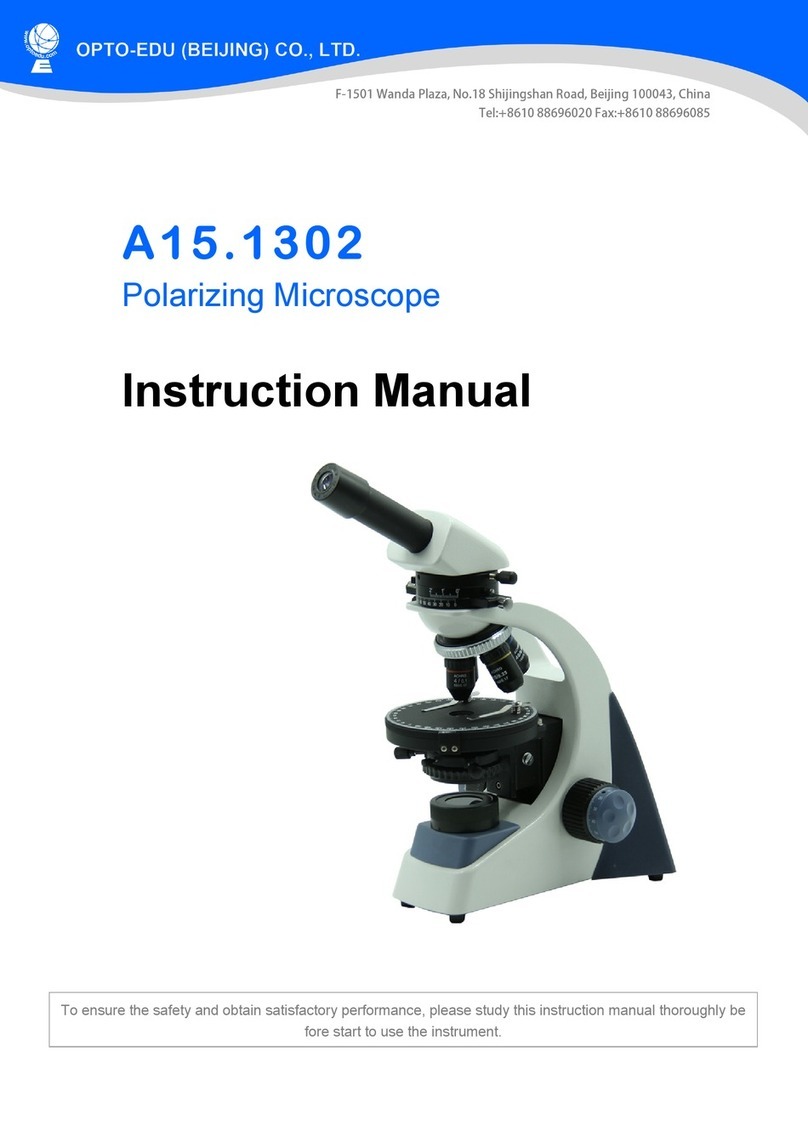
OPTO-EDU
OPTO-EDU A15.1302 instruction manual
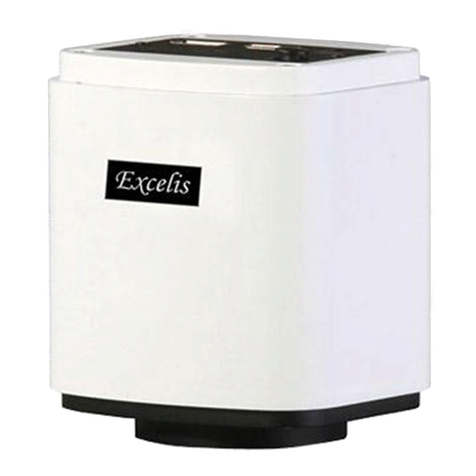
Accu-Scope
Accu-Scope Excelis HD quick start guide

